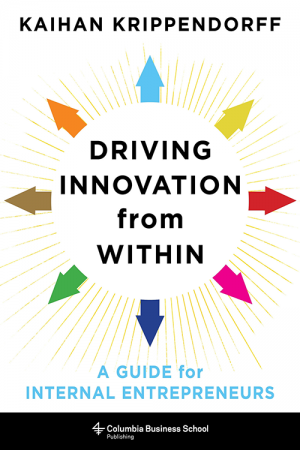Dispelling the Myth of the Superstar Entrepreneur: Most Innovations Actually Come From Employees

By now, we all know the story: The lone entrepreneur arrives on the scene, ready to shake up the industry with his brilliant innovation. He heroically battles naysayers and the risk-averse to bring his new idea to fruition. It’s a smash hit that radically transforms his industry — and the way we live.
Except, that story isn’t really true. Sure, it happens occasionally, but according to research conducted by Dr. Kaihan Krippendorff, it’s the exception rather than the rule.
Krippendorff, a former McKinsey consultant and the founder and CEO of growth strategy consulting firm Outthinker, spent years studying employee-driven innovation. He interviewed more than 150 intrapreneurs. His conclusion: employees have driven more than 70 percent of society’s most impactful innovations over recent decades.
“Were it not for employee-innovators, we would live in a radically inferior world,” Krippendorff says. “You would have no mobile phones, or internet to connect it to, or email to send; if you got sick, your doctors would have no MRI or stent to offer.”
Krippendorff explores his research further in his latest book, Driving Innovation from Within: A Guide to Internal Entrepreneurs. Below, we talk to Krippendorff to learn more about the real story behind innovation and what organizations can do to unleash the inventive power of their workers in the trenches.
Recruiter.com:The book focuses on the fact that the popular notion we have of innovation is, in large part, not commensurate with the reality.
For example, you share the story of Swoon Reads, a crowd-sourced manuscript discovery initiative at Macmillan Publishers. You note that “Swoon Reads’s path from idea to realization involved none of the formal structures or practices espoused by innovation experts. Instead, the journey was entirely spontaneous, organic, self-directed, and, for much of its path, done without the approval of funding or extra time. It was a labor of love, a movement generated by a group of passionate employees who saw a possibility and worked collectively to realize it.”
I wonder, then: Where did the “formal structures or practices espoused by innovation experts” come from if they don’t seem to serve the reality of how innovation happens, and why are we still in thrall to those structures and practices today?
Kaihan Krippendorff: I think we are enthralled with formal innovation structures and practices for two reasons.
The first is that these are things leadership can control fairly easily. Establishing an “incubation lab” or opening an office near Silicon Valley are things that leaders in an organization can fund and direct to happen, but establishing a culture and organizational context that encourages spontaneous innovation is harder and takes longer.
The second reason is that formal innovation practices are more likely to attract the attention of the press and investors, which naturally motivates leadership to focus on them. The allure of “innovation theater” is too strong for many companies to resists.

KK: Years ago, I ran a nonprofit that helped at-risk children who would be first-generation college students make it through high school into college. We found that one of the powerful things you can do to get these students to see college as a possibility was to expose them to mentors who shared stories of what it was like to complete college.
The stories we hear influence what we believe to be possible. The fact that we don’t tell stories about employee-innovators, and instead talk almost exclusively about entrepreneurs, essentially communicates to would-be internal entrepreneurs that they are not meant to be the innovators. We need employees to innovate. They have historically contributed more than 70 percent of society’s most impactful innovations. We should be studying and celebrating employee-driven innovation because we all need employee-driven innovations.
RC:You write,”[W]hen we study what actually makes great companies great, we see that success depends more on the founder’s ability to create a system in which employees can bring ideas to reality. The ideas that turn organizations into market-shaping disruptors often come years after the original founder’s vision.”
I’m really intrigued by this notion of “the founder’s ability to create a system in which employees can bring ideas to reality.” Could you elaborate a bit on what such a system entails?
KK: Research shows that to create a system in which employees can innovate requires brining together four sets of drivers.
First, you need leadership that prioritizes innovation and that makes the right choices to build the context in which people can innovate.
Second, you need the right kind of talent, with the right kinds of attributes that make them effective at driving innovation from within. These attributes are similar to but different from the attributes of effective entrepreneurs.
You need organizational structures that celebrate innovative behavior, allow for risk-taking, provide resources to fuel innovation, and allow the organizational freedom to allow people to work on things that are not directly related to their roles.
Finally, you need a culture that supports things like innovative thinking, proactivity, and risk-taking.
The drivers are actually well known. Figuring out what needs to be done is not hard, but actually having the determination to do it is.
For more expert HR insights, check out the latest issue of Recruiter.com Magazine:
RC: Many people throw around terms like “intrapreneur” these days, with the understanding being that an “intrapreneur” is essentially an entrepreneur who works inside of a company rather than starting their own. However, you point out that internal innovators are not “just entrepreneurs drawing a paycheck from someone else.” Could you elaborate on that?
KK: The character of successful intrapreneurs differs in some important ways from that of entrepreneurs. Both tend to be innovative thinkers, understand the customer and market, and take proactive action — but that is where their similarities end.
Successful intrapreneurs are not risk-seeking but rather like to create what I call “risk asymmetry”: They look to create situations in which they can bet a little with the potential of benefiting a lot. They are intrinsically motivated to innovate, meaning that they don’t do it for the financial payoff but more so for the impact they can have. And finally, they are not only good at organizational politics, they enjoy it. They see the political game simply as part of the problem-solving process.
RC: Your book introduces the “IN-OVATE” framework. It’s a comprehensive framework — and our readers will have to pick up the book themselves to get a full understanding of it — but would you mind giving us the nutshell version of the framework? What is it, and why is it important?
KK: I interviewed 150 internal innovators and asked each what were the primary barriers they had to overcome to successfully drive an innovation from within. Their answers were actually quite consistent, and they outline a path that anyone who seeks to be an internal innovator is likely to follow.
- Intent: activating you intention to seek and find innovation opportunities. Without intent, you are unlikely to even spot such opportunities.
- Need: Less that 55 percent of mid-level managers can name even two of their company’s top strategic priorities, which means that if they do decide to look for innovations, they risk looking in the wrong places. You need to know what your company needs.
- Options: the ability to generate innovative solutions to the needs you identify.
- Value blockers: Your innovative ideas will likely involve a business model that is different from your company’s current business model. Each point of conflict represents a “value blocker” you will want to untangle.
- Act: To prove a new idea usually requires first taking action, but established organizations will usually ask you prove the idea before they let you take action. You can unravel this catch-22 by learning how to conduct small, inexpensive experiments.
- Team: A new idea will usually require assembling an agile, cross functional team around the innovation. Unfortunately, unless you report directly to the CEO, your boss will not have the authority to command all the people you need to work on your innovation. What this means is, at least in the initial stage, you need to build spontaneous excitement to build a groundswell of support around your idea. You have to get people to advance your idea even if they have no formal motivation to do so.
- Environment: This speaks to your internal organizational environment. You want to find the right mix of talent, leadership, organizational structure, and subculture to create an island of freedom in which you are free to pursue your innovation.
RC: Ultimately, what lessons do you hope people will walk away from this book with? And how do you hope people apply those lessons moving forward?
KK: Innovation is always hard because it requires you to pursue a new idea that is inconsistent with the way things have been done before. It’s hard whether you are an entrepreneur or intrapreneur. Just because you face challenges as an intrapreneur does not mean the effort is impossible or worthwhile. Indeed, it just means that you are on to something new and exciting. See every “no” as a sign you are doing something new. See every “no” as simply another problem to solve.

